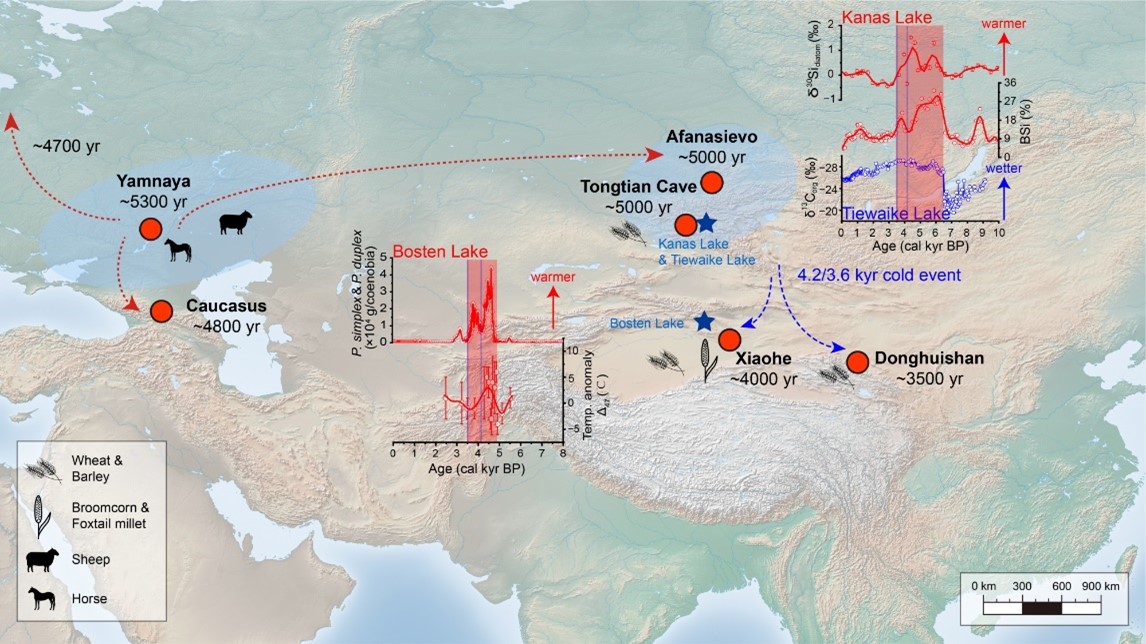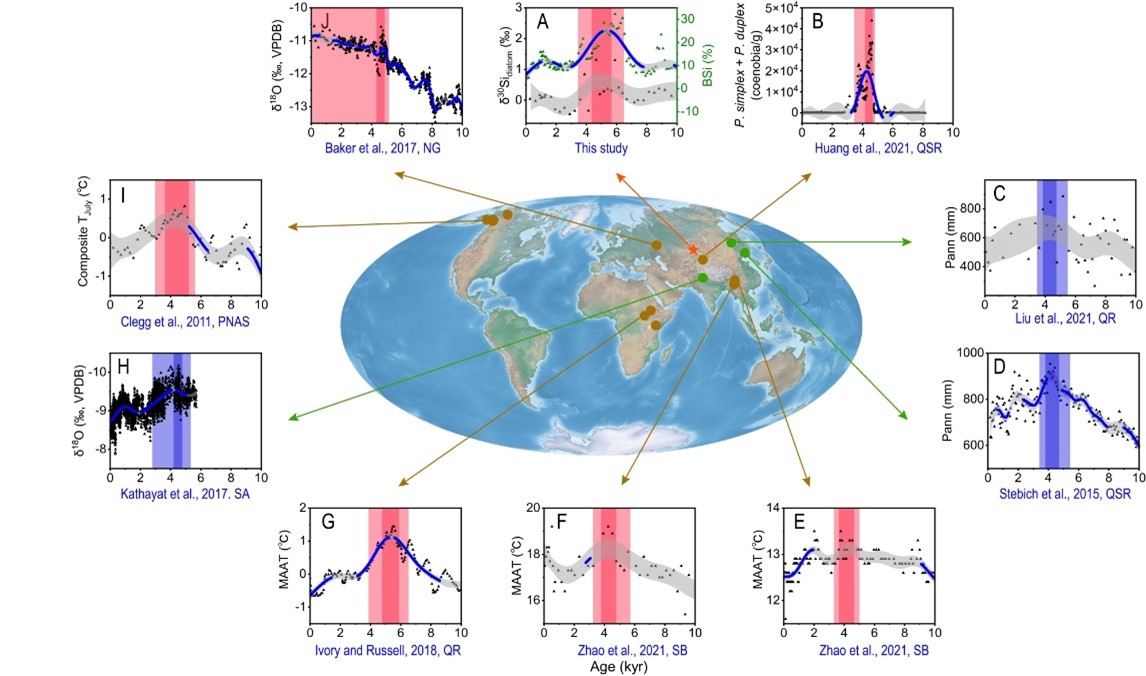The Central Asian Grassland Road is of great significance to the prehistoric exchanges between Eastern and Western civilizations. The Altai Mountains area is the core of the Eurasian continent, and it is also a key area of the Silk Road in the grasslands of central Asia and one of the important passages for early exchanges between Eastern and Western civilizations. Archaeological and genetic evidence found that in the early Bronze Age, the Yamnaya population migrated from the southeastern part of the Eastern European steppe to the southern Siberia region and the west side of the Altai Mountains about 5ka (ka = thousand years ago), and developed into the Avanasievo ( Afanasievo) culture (Figure 1). There are multiple hypotheses about the drivers of long-distance human migrations during this period, including the spread and spread of agriculture and language, the domestication of horses, and the use of secondary animal products such as dairy. However, the research on the climatic background factors of regional population dispersal is not deep enough. The Holocene temperature change is highly controversial, and the climate proxy indicators and the results of climate model simulations show an opposite trend, which is called the "Holocene temperature mystery". Many recent studies have attempted to explain this puzzle by using the seasonal bias of climate proxy indicators, the multiple solutions of indicators, and the spatial heterogeneity of Holocene temperature changes, but there are still many uncertainties.

Figure 1. Schematic diagram of prehistoric population dispersal driven by warm and suitable climate in the Central Asian steppe belt
Based on Kanas Lake and Tiewaike Lake located on the southern slope of the Altai Mountains, a team led by Professor Huang Xiaozhong of Lanzhou University has revealed the temperature history of Kanas Lake since the Holocene by using the δ30Sidiatom and biosilicon content of Kanas Lake sediments. The results showed that the climate in the Altai region was generally warm during 6.5-3.6ka, and the diatom grew and flourished in Kanas Lake. During 4.7-4.3ka, the climate was abnormally warm, the lake was significantly stratified, and the silicon isotope of diatom was obviously heavy. Combined with the parameters of palynology, carbon and nitrogen isotopes of the Tieweike Lake borehole and the regional humidity records, the climate in the Altai region was suitable during 6.5-3.6ka. At about 5ka, the Yanayans living in the lower Caspian Sea showed drought in the region, and migrated to southern Siberia and the Altai region. At 4.8-4.7ka, the Yanayans migrated to the high altitudes of the Caucasus and the higher latitudes of Northern Europe (Figure 1).The study provides a new perspective and new evidence on the drivers of prehistoric population expansion in Central Asia.The study entitled "PrehistoricpopulationexpansioninCentralAsiapromotedbytheAltaiHoloceneClimaticOptimum (altai holocene middle-late suitable climate promote central Asian steppe zone prehistoric human expansion)"Is published in NatureCommunications.

Figure 2. Comparison of multiple global temperature (red bands indicating warm) and humidity (blue bands indicating wet) records
The work is an extension of Huang's Quaternarysciereviews, which was published in 2021. In this study, it was found that tropical and subtropical thermotropic species monoceratophora appeared in the sediments of Bostan Lake, Xinjiang, indicating a high-temperature event of 4.7-4.3ka. The warm climate could guarantee the prehistoric people living in the Altai Mountains (Chimulcek culture). As the climate suddenly cooled at 4.2ka and 3.6ka, the population spread to lower latitudes. It formed the early population in the Tarim Basin (e.g., Xiaohe Site) (Huang et al.,2021QSR), and the large-scale animal husbandry development in the Loess Plateau after 4ka (Huang et al.,2021GRL), which further promoted the exchanges between Eastern and Western civilizations.
Lixiong Xiang, Ph.D. candidate in 2019, College of Earth and Environmental Sciences, Lanzhou University, is the first author of the paper, and Prof. Xiaozhong Huang is the first corresponding author. Professor Huang Xiaozhong, the principal designer of the study, has carried out more than 10 field works in Kanas Lake since 2011. Xiang Lixiong collected and analyzed a large amount of archaeological data and measured and analyzed carbon and nitrogen isotopes in Tiewaike Lake. Sun Mingjie, Master of Physical Geography, Lanzhou University, 2020, Ph.D. student, University of Nottingham, measured silicon isotope and biosilicon content of diatoms at the British Geological Survey (BGS). Dr. VirginiaN Panizzo, University of Nottingham, UK, directed the silica isotope determination of diatoms (second corresponding author). Co-authors include Dr. Chen Xuemei from Northwest Institute of Eco-Environment and Resources, Chinese Academy of Sciences; Doctoral candidates Huang Chong and Zheng Min from Lanzhou University; The overall study was completed under the guidance of academician Chen Fahu from Institute of Tibetan Plateau Research, Chinese Academy of Sciences.
This work was supported by the National Natural Science Foundation of China (41991251), the National Key Research and Development Program of China (2017YFA0603403) and the National Natural Science Foundation of China (41571182). The field and indoor analysis has been helped by many colleagues and students, and I would like to express my thanks here.
Related main achievements:
Xiang, L.X., Huang, X.Z.*, Sun, M.J., Panizzo, V.N.*, Huang, C., Zheng, M., Chen, X.M., Chen, F.H., 2023. Prehistoric population expansion in Central Asia promoted by the Altai Holocene Climatic Optimum. Nature Communications, 14, 3102.https://www.nature.com/articles/s41467-023-38828-4#Sec13
Huang, X.Z.*, Xiang, L.X., Lei, G.L.*, Sun M.J., Qiu M.H., Storozum M., Huang C., Munkhbayar C., Demberel O., Zhang J., Zhang J.W., Chen X.M., Chen J.H., Chen F.H., 2021. SedimentaryPediastrumrecord of middle–late Holocene temperature change and its impacts on early human culture in the desert-oasis area of northwestern China. Quaternary Science Reviews, 265, 107054. http://dx.doi.org/10.1016/j.quascirev.2021.107054
Huang, X.Z.*, Zhang, J., Ren, L.L., Zhang, S.R., Chen, F.H., 2021. Intensification and Driving Forces of Pastoralism in Northern China 5.7 ka Ago. Geophysical Research Letters, 48, e2020GL092288. https://doi.org/10.1029/2020GL092288